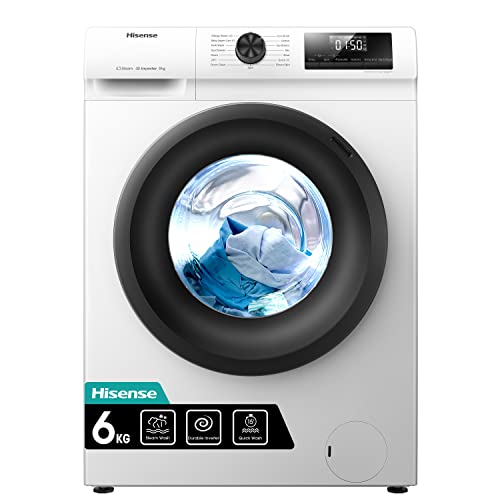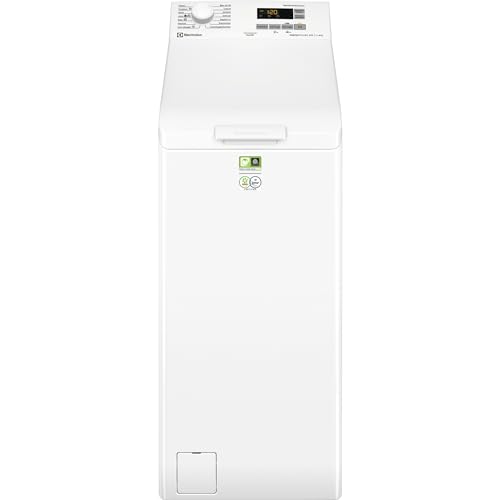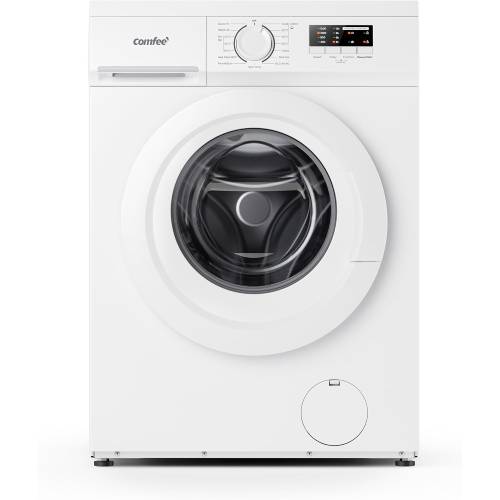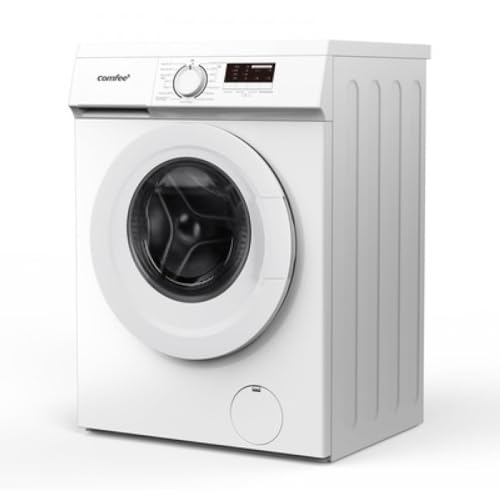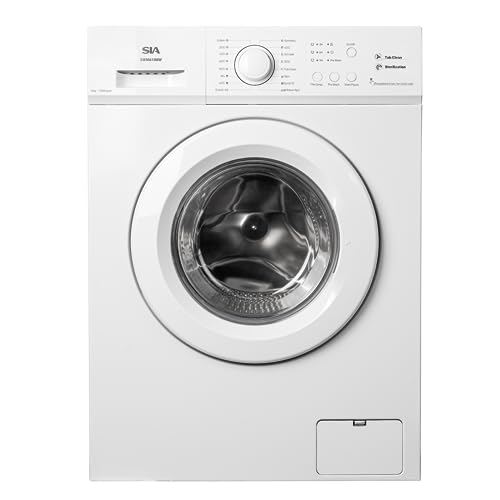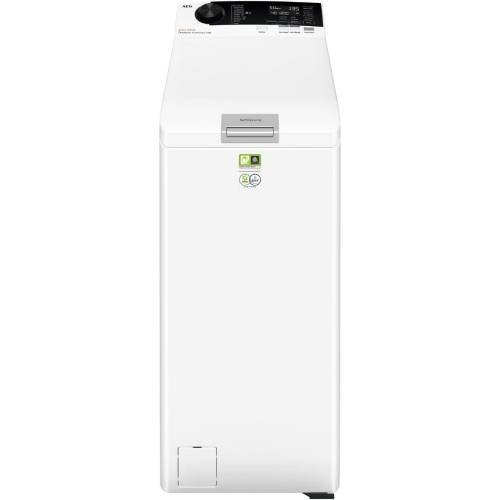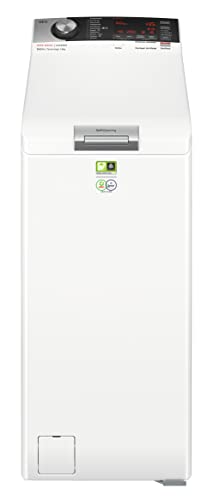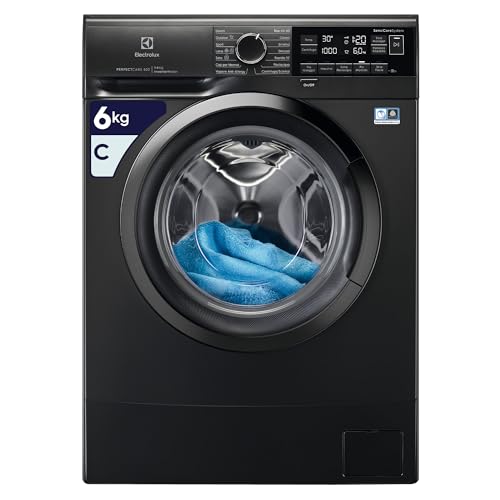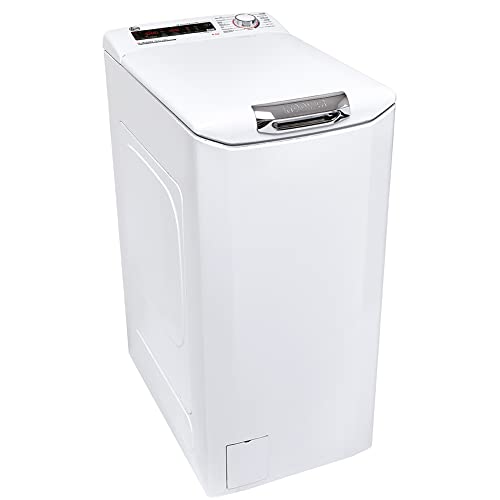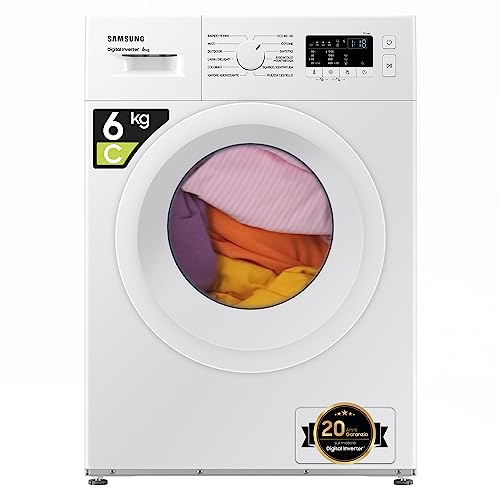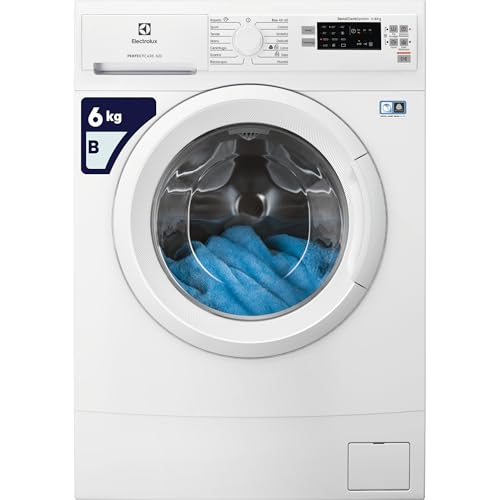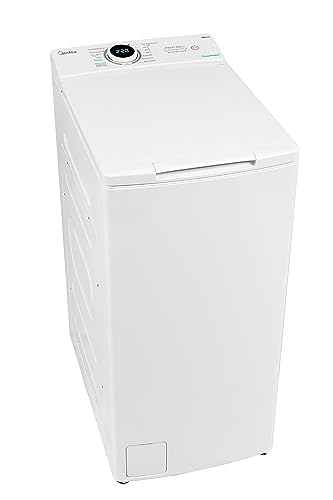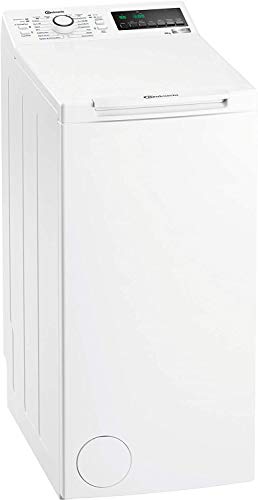Are 6 kg washing machines worth it?
6 kg washing machines achieve an average overall score of 6.2 points, lower than the market average of 7.1 points. Their performance is similar to that of 7 kg washing machines, but inferior compared to 8 kg models (7.1 points) and 9 kg models (7.5 points).
However, 6 kg washing machines receive a user rating of 8.1 points, higher than 7 kg (8.2 points) and 8 kg models (7.9 points), and equal to 9 kg models.
About 8% of all washing machines on the market have a 6 kg capacity.
The best 6 kg washing machines with the highest overall scores are as follows.
- Hisense WFQP6012EVM QP Serie (Overall score: 7.1 points)
- Electrolux EW6T526C SensiCare 600 (Overall score: 6.42 points)
- Russell Hobbs RH612W110W (Overall score: 5.65 points)
What are the main advantages of 6 kg washing machines compared to others?
6 kg washing machines offer the following advantages compared to other capacities.
- Model availability: the 6 kg category includes many front-loading and top-loading models.
- Lower cost: 6 kg washing machines cost around £280 (£100 less than the market average of £380) and achieve a good ratio quality-price of 7 points.
- Higher user ratings: most 6 kg washing machines receive slightly better user ratings than the market average.
- Spin speed suitable for delicate fabrics: 76% of 6 kg washing machines can achieve a minimum spin speed of 400 rpm.
- Faster ECO cycles: ECO cycles in 6 kg washing machines take about 23 minutes less than the market average (195 minutes vs. 218 minutes).
- Specialised wash cycles: 6 kg washing machines often include cycles such as Anti-Stain, Jeans, Duvet, Hygiene, Baby Care, or Outdoor.
- Advanced features: most 6 kg washing machines are equipped with a foam control system, unbalanced load detection, laundry detection, and Pause & Add functionality. Some models also offer load balancing systems, AquaStop system, pre-mix technology, NFC connectivity, soft-opening doors, and automatic drum positioning.
What are the main disadvantages of 6 kg washing machines compared to others?
The disadvantages of 6 kg washing machines compared to other capacities are as follows.
- Limited availability: 6 kg washing machines are less common on the market than 7 or 8 kg models.
- Smaller drum volume: the drum volume of a 6 kg washing machine is about 16 litres smaller than the market average (42 L vs. 58 L).
- Lower energy efficiency: a 6 kg washing machine consumes an average of 64 kWh, compared to the market average of 55 kWh. The average energy class for a 6 kg washing machine is D, compared to the market average of B.
- Poorer water extraction: only about 6% of 6 kg washing machines can achieve a maximum spin speed of 1400 rpm or higher, compared to about 60% of all washing machines on the market.
- Fewer inverter motors: about 35% of 6 kg washing machines are equipped with inverter motors, compared to 79% of washing machines on the market.
- Higher noise levels: 6 kg washing machines are slightly noisier, with an average spin noise level of 76 dB compared to 75 dB, and an average washing noise level of 58 dB compared to 53 dB.
- Fewer washing programs: 6 kg washing machines have an average of 14 washing programs, compared to the market average of 15 programs.
- Less common wash cycles: cycles such as Shirts, Hygiene, or Anti-Allergy are less available in 6 kg washing machines compared to those with larger capacities.
- Fewer functions: 6 kg washing machines have about 2 fewer functions on average than the market average (8 vs. 10).
- Limited advanced features: features such as steam technology, self-cleaning, smart diagnosis, automatic drawer cleaning, automatic dosing, Wi-Fi connectivity, or AI integration are less common in 6 kg washing machines compared to larger capacities.

Are 6 kg washing machines big enough?
A 6 kg washing machine is ideal for small households (usually one or two people) and can comfortably handle smaller loads such as clothing, bedding, or a single person’s weekly laundry. This capacity is perfect for apartments or homes with limited space.
However, it may not be suitable for bulky items like large blankets or heavy loads, which may require a higher capacity. If you are a family with more than two people or have higher washing needs, a larger capacity washing machine would be a better choice.
How many clothes can you fit in a 6 kg washing machine?
A 6 kg washing machine can hold several items, but the total weight of dry clothing should not exceed 6 kg. Capacity refers to the maximum load of dry laundry the machine can effectively handle. To understand what can be loaded into a 6 kg washing machine, it is helpful to know the weight of various clothing items and their contribution to the total load.
The following list provides a general idea of what a 6 kg washing machine can hold.
- T-shirts: approximately 25 lightweight cotton T-shirts. Each T-shirt weighs about 200-250 grams, so a full load could include 20-30 T-shirts, depending on the fabric and size.
- Jeans: about 7-8 pairs of jeans. Each pair typically weighs between 700 and 800 grams, so you can wash around 4-5 pairs without exceeding the machine’s capacity.
- Towels: about 7-8 medium-sized bath towels. A standard bath towel weighs around 600-700 grams, allowing you to wash 5-6 towels comfortably.
- Bedding: one or two sets of lightweight bedding (including duvet cover, sheet, and pillowcases). The weight of bedding varies, but a single standard set usually weighs around 1.5-2 kg.
- Shirts: approximately 15-20 shirts, depending on the material and size. A medium shirt weighs about 300 grams.
As an example, the image below shows the Samsung WW65AA126AE/LE washing machine with a 6.5 kg capacity.
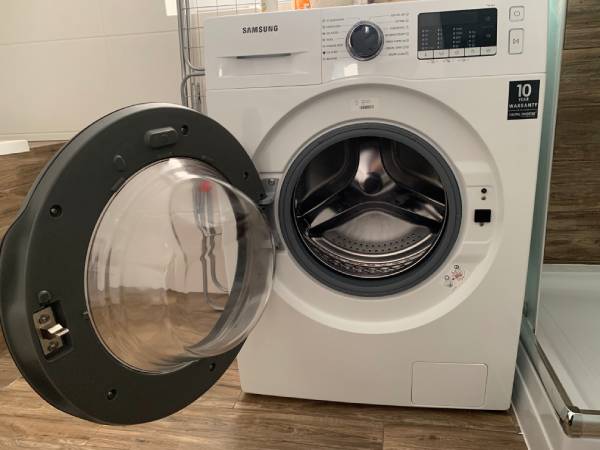
How much do 6 kg washing machines cost?
A 6 kg washing machine costs between £200 and £600, with an average price of around £280. In comparison, a 7 kg washing machine costs an average of about £330, an 8 kg machine around £370, and a 9 kg machine about £480. These are among the most affordable washing machines on the market.
The chart below shows the price distribution of 6 kg washing machines.
[vertical-chart-58400547]
6 kg washing machines have a ratio quality-price score of 7 points, slightly above the market average of 7.1 points.
The cheapest 6 kg washing machines available are as follows.
- SIA SWM6100W (~£200)
- Comfee CFE10EW60/W (~£200)
- Comfee CFE10W60 (~£210)
The following washing machines offer the best ratio quality-price for a 6 kg capacity.
- Hisense WFQP6012EVM QP Serie (Ratio quality-price: 7.89 points)
- Comfee CFE10EW60/W (Ratio quality-price: 7.35 points)
- Comfee CFE10W60 (Ratio quality-price: 7.19 points)
What are the best brands of 6 kg washing machines?
The best brands of 6 kg washing machines are as follows.
- AEG (Average overall score: 6.8 points)
- Electrolux (Average overall score: 6.7 points)
- Bauknecht (Average overall score: 6.7 points)
The following chart illustrates the ranking of the best brands of 6 kg washing machines based on their average overall score.
[horizontal-chart-62556308]
What are the top-rated brands of 6 kg washing machines according to users?
The top-rated brands of 6 kg washing machines according to user ratings are as follows.
- Candy (Average user rating: 8.6 points)
- Indesit (Average user rating: 8.5 points)
- Comfee (Average user rating: 8.4 points)
The chart below shows user ratings for brands of 6 kg washing machines.
[horizontal-chart-37495809]
(Only brands with at least 3 models of 6 kg washing machines in our database were considered).
What should you consider when choosing the best 6 kg washing machine?
When selecting the best 6 kg washing machine, consider factors such as energy consumption (energy efficiency class), water consumption per cycle, spin efficiency, noise level during washing, motor type, number of washing programs, and technical features. Also, evaluate the drum volume and machine dimensions to ensure they fit your space.
Are 6 kg front-loading washing machines better than top-loading ones?
6 kg top-loading washing machines tend to outperform front-loading ones with the same capacity. Top-loading models achieve an overall score of 6.3 points, while front-loading models score 5.6 points. On the market, approximately 50% of 6 kg washing machines are top-loading, and 50% are front-loading.
This is the only capacity where top-loading washing machines outperform their front-loading counterparts.
The chart below illustrates the distribution of 6 kg washing machines based on loading type.
[pie-chart-73804090]
6 kg top-loading washing machines have the following advantages over front-loading ones.
- Higher ratings and popularity: 6 kg top-loading washing machines have an average user rating of 8.1 and a popularity score of 7.3, compared to front-loading models with 8.1 and 7.3 respectively.
- More inverter motors: 41% of 6 kg top-loading washing machines feature inverter motors, compared to 29% of front-loading models.
- Better energy efficiency: Top-loading washing machines are generally rated as energy class C, while front-loading ones are class D. About 29% of top-loading models achieve class B, while no front-loading model reaches class B or A.
- Lower energy consumption: 6 kg top-loading washing machines use approximately 9 kWh less per 100 cycles than front-loading models (56 kWh vs. 65 kWh).
- Higher spin speeds: 82% of 6 kg top-loading washing machines reach a maximum spin speed of at least 1200 rpm, compared to 29% of front-loading models.
- Suitable for delicate fabrics: 88% of 6 kg top-loading washing machines can achieve a minimum spin speed of 400 rpm, while only 58% of front-loading models can.
- Specialised wash cycles: Top-loading models more often include cycles like Anti-Stain, Jeans, and Duvet.
- More functions: 6 kg top-loading washing machines have an average of 9 functions, while front-loading ones have 5.
- Advanced features: Features such as AquaStop, foam control, load balancing, pre-mix technology, and automatic dosing systems are more common in 6 kg top-loading washing machines. Some models also feature Wi-Fi connectivity, which is not available in front-loading models.
- Compact dimensions and lower weight: 6 kg top-loading washing machines occupy an average of 0.215 m³ and weigh about 57 kg, while front-loading models occupy 0.227 m³ and weigh 58 kg.
- Ease of loading and unloading: Top-loading washing machines allow convenient access from the top.
- Less prone to mould and odours: Top-loading washing machines are less likely to have issues with mould and odours compared to front-loading models.
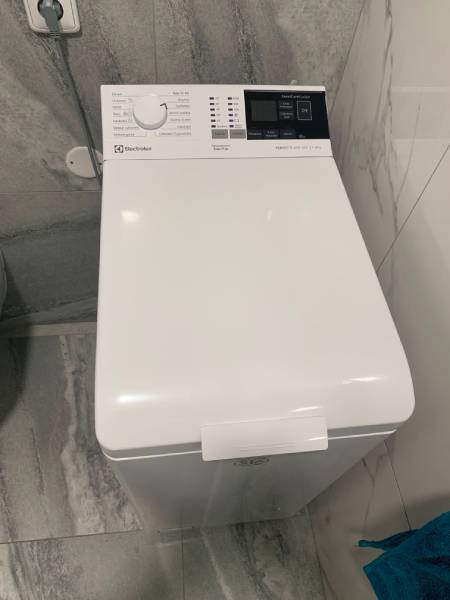
6 kg front-loading washing machines have the following advantages over top-loading ones.
- Lower price: Front-loading models are on average £100 cheaper (£260 for front-loading vs. £360 for top-loading).
- Larger drum volume: Front-loading washing machines have an average drum volume of 44 litres, 2 litres more than top-loading models.
- Quieter during spinning: Front-loading washing machines produce an average noise level of 76 dB during spinning, slightly quieter than top-loading models at 77 dB.
- More washing programs: Front-loading models generally offer 15 washing programs, one more than the 14 in top-loading models.
- Additional cycles: Front-loading washing machines more often include specialised cycles such as Baby Care, Anti-Allergy, and Shirts.
- Self-cleaning function: 50% of front-loading washing machines include the self-cleaning function, compared to 29% of top-loading models.
The best 6 kg front-loading washing machines are as follows.
- Hisense WFQP6012EVM QP Serie (Overall score: 7.1 points)
- Russell Hobbs RH612W110W (Overall score: 5.65 points)
- Comfee CFE10EW60/W (Overall score: 5.51 points)

What is the drum volume of 6 kg washing machines?
The drum volume of 6 kg washing machines ranges from 40 to 54 litres, with an average of 42 litres, which is smaller than the market average of 58 litres. In comparison, 7 kg washing machines have an average drum volume of 48 litres, while 8 kg models reach 55 litres. Front-loading 6 kg washing machines generally have about 2 litres more drum volume than top-loading models (44 litres vs. 42 litres).
The distribution of drum volume sizes among 6 kg washing machines is shown in the chart below.
[vertical-chart-89487059]
Drum volume is particularly important when washing bulky items or larger loads. A larger drum reduces the number of washes needed, saving time and energy, and impacts drying capacity and cleaning effectiveness.
The following 6 kg washing machines have the largest drum volumes.
- Hisense WFQP6012EVM QP Serie (Drum volume: 54 L litres)
- Russell Hobbs RH612W110W (Drum volume: 44 L litres)
How much space do 6 kg washing machines take up?
6 kg washing machines take up between 0.2 and 0.26 m³, with an average volume of 0.216 m³ (this means they require less space compared to larger capacity washing machines). For instance, 6 kg washing machines use 14% less space than 7 kg models (0.25 m³) and about 23% less than 8 kg models (approximately 0.28 m³).
The depth of 6 kg washing machines ranges from 38 to 60 cm, allowing for many slim models, including some super slim ones with a depth of less than 44 cm. The width varies from 40 to 60 cm; top-loading washing machines are typically around 40 cm wide, while front-loading models have an average width of about 60 cm.
The 6 kg washing machines that take up the least space are as follows.
- Comfee CFE10W60 (Volume: 202300 cm³)
- Comfee CFE10EW60/W (Volume: 202300 cm³)
What is the energy efficiency of 6 kg washing machines?
6 kg washing machines are less energy efficient compared to those of other capacities. The energy classes of these washing machines range from B to G, with class D being the most common (35%). Only 15% of 6 kg washing machines are rated class B, while 29% are class C. Around 12% are class E, 6% class F, and 3% class G. By comparison, about 39% of all washing machines on the market are class A and 17% class B, highlighting that 6 kg washing machines are less energy efficient.
The distribution of energy classes among 6 kg washing machines is shown in the chart below.
[pie-chart-96762651]
Energy consumption is closely tied to energy classes: class A washing machines consume less than 49 kWh per 100 cycles, while class B machines stay below 55 kWh. However, this relationship may vary depending on capacity.
Energy consumption for 6 kg washing machines ranges from 48 to 83 kWh per 100 cycles, with an average of 64 kWh. 9 kg washing machines have the lowest average energy consumption at just 49 kWh per 100 cycles. If you prefer a 6 kg washing machine but want to minimise energy costs, consider a front-loading model rather than a top-loading one, as front-loading washing machines consume about 14% less energy (56 kWh vs. 65 kWh per 100 cycles).
Generally, higher capacity machines have greater average water consumption: 7 kg washing machines use an average of 45 litres per cycle, while 9 kg models use about 49 litres.
The following chart shows the energy consumption distribution (per 100 cycles) of 6 kg washing machines.
[vertical-chart-55761221]
The most energy-efficient 6 kg washing machines are as follows.
- Hisense WFQP6012EVM QP Serie (Energy consumption: 56 kWh/100 cycles per 100 cycles)
- Electrolux EW6T526C SensiCare 600 (Energy consumption: 56 kWh/100 cycles per 100 cycles)
- Comfee CFE10W60 (Energy consumption: 64 kWh/100 cycles per 100 cycles)
What is the spin efficiency of 6 kg washing machines?
The spin efficiency of 6 kg washing machines falls within class B or C. 53% of these washing machines have a class B efficiency, and 42% have a class C efficiency. The most common spin efficiency class among all washing machine capacities is class B, representing 85%, followed by class C with 10% and class A with 5%.
The chart below shows the distribution of spin efficiency classes for 6 kg washing machines.
[pie-chart-25015347]
The spin efficiency class reflects the amount of moisture remaining in clothes after spinning. A higher class, such as class A, indicates less moisture remaining, allowing clothes to dry faster. This efficiency is closely related to the maximum spin speed of the washing machine.
For 6 kg washing machines, the maximum spin speed ranges from 1000 to 1500 rpm, with 1200 rpm being the most common (49%), followed by 1000 rpm (42%). These values are below the market average, where 60% of washing machines have a spin speed of 1400 rpm and 22% of 1200 rpm.
Higher spin speeds accelerate drying times by removing more water from clothes, particularly useful for heavy fabrics or bulky loads. However, if you often wash delicate items, consider the minimum spin speed.
For 6 kg washing machines, the minimum spin speed ranges from 400 to 800 rpm, with 76% of models offering a minimum spin speed of 400 rpm, ideal for protecting delicate fabrics.
How noisy are 6 kg washing machines?
6 kg washing machines have spin noise levels ranging from 74 dB to 80 dB, with an average of 76 dB (1 dB higher than the market average of 75 dB). Spin noise is the loudest phase of the washing cycle and is a key indicator of the machine’s overall noise level.
The chart below shows the range of spin noise levels for 6 kg washing machines.
[vertical-chart-65740149]
Consider the noise emission class, which is closely tied to spin noise levels. This class is divided into four categories from A to D as follows:
- A: noise level below 73 dB
- B: noise level between 73-76 dB
- C: noise level between 77-80 dB
- D: noise level above 80 dB
For 6 kg washing machines, the noise emission class predominantly falls into categories B (51%) or C (47%).
Washing noise levels for 6 kg washing machines range from 52 dB to 61 dB, with an average of 58 dB, higher than the market average of 53 dB. While washing noise is less critical than spinning noise, it is still worth considering.
How many washing programs do 6 kg washing machines offer?
6 kg washing machines typically offer between 10 and 16 washing programs, with an average of 14 programs, slightly below the market average of 15. They generally include 1-2 quick cycles under an hour, while ECO cycles last between 180 and 200 minutes, averaging about 195 minutes, 23 minutes less than the market average.
Basic programs in these washing machines include Cotton, Eco 40-60, Synthetics, Quick, Mixed, and Wool/Delicates. Many models also feature specialised programs like Anti-Stain (45%), Jeans (35%), Duvet (35%), Hygiene (32%), Baby Care (23%), and Outdoor (68%).
Washing programs in 6 kg washing machines are generally similar to those in larger capacity models. However, some cycles are less common in 6 kg washing machines compared to other capacities, such as the Anti-Allergy cycle (45% compared to 68% market-wide), Shirts cycle (19% vs. 42%), and Hygiene cycle (32% compared to 59%).
The chart below shows the distribution of the number of washing programs in 6 kg washing machines.
[vertical-chart-24144316]
Many 6 kg models include useful features such as the quick function (45% of models), extra rinse (85%), prewash (97%), anti-crease (56%), rinse hold (29%), and anti-stain function (39%). A few models also offer wash assist (12%) and silent operation (18%).
What features do 6 kg washing machines have?
A 6 kg washing machine typically includes between 5 and 14 features, two fewer than standard washing machines, which average 8 features compared to 10.
The chart below presents the distribution of features in 6 kg washing machines.
[vertical-chart-20825944]
The features of 6 kg washing machines are similar to those of other capacities, with some exceptions. Most 6 kg models include functions like foam control (84%), unbalanced load detection (85%), laundry detection (77%), and Pause & Add (82%).
Less common are load balancing systems (35%), AquaStop (24%), pre-mix technology (16%), NFC connectivity (13%), soft-opening doors (41%, available only in top-loading machines), and automatic drum positioning (26%, also in top-loading machines).
The following features are less widespread in 6 kg washing machines compared to larger capacity models.
- Steam technology (24% of 6 kg washing machines, compared to 57% market-wide)
- Self-cleaning (39% vs. 66%)
- Smart diagnosis (19% vs. 43%)
- Special drum design to protect clothes (<5% vs. 46%)
- Automatic drawer cleaning (<2% vs. 12%)
- Automatic dosing system (<2% vs. 7%)
- Wi-Fi (<5% vs. 23%)
- AI technology (<2% vs. 11%)
Only 32% of 6 kg washing machines have efficient inverter motors (compared to 79% of all washing machines on the market).
The 6 kg washing machines with the highest number of features are as follows.
- Hisense WFQP6012EVM QP Serie (10 features)
- Electrolux EW6T526C SensiCare 600 (10 features)
- SIA SWM6100W (2 features)

